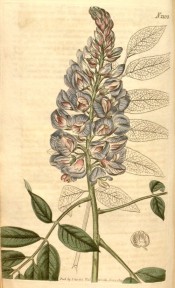Wisteria frutescens (L.) Poir.
Fully-hardy tall climber with leaves composed of up to 17 leaflets, and racemes, to 15cm long, of fragrant, pale lilac-purple flowers with a yellow spot, in summer. [RHSD, Hilliers’, Hortus].
Horticultural & Botanical History
‘A very ornamental shrub, tolerably hardy, but does not flower very readily except in favourable situations. There used to be a very fine plant trained up against the house at Messrs. Loddiges and Sons at Hackney, which, in some years, bore a profusion of flowers. Our drawing was taken from a specimen communicated in June last by Thomas Wildman, Esq. late of Layton. Grows naturally in the swamps of Virginia, Carolina, and the Illinois. Introduced in 1724 by Mr. Mark Catesby.’ [BM t.2103/1819]. The variety magnifica, with paler flowers, was figured in Flore des Serres. [FS f.1151/1856].
History at Camden Park
Listed in the 1843, 1845 and 1850 catalogues. Plants were presented to the Sydney Botanic Garden on October 24th 1846.
Notes
Published Dec 23, 2009 - 12:53 PM | Last updated Jul 21, 2010 - 02:38 PM
| Family | Fabaceae |
|---|---|
| Category | |
| Region of origin | South east USA |
| Synonyms |
|
| Common Name | Carolina kidney bean, American wisteria |
| Name in the Camden Park Record |
Glycine frutescens - Carolina Kidney-bean |
| Confidence level | high |
